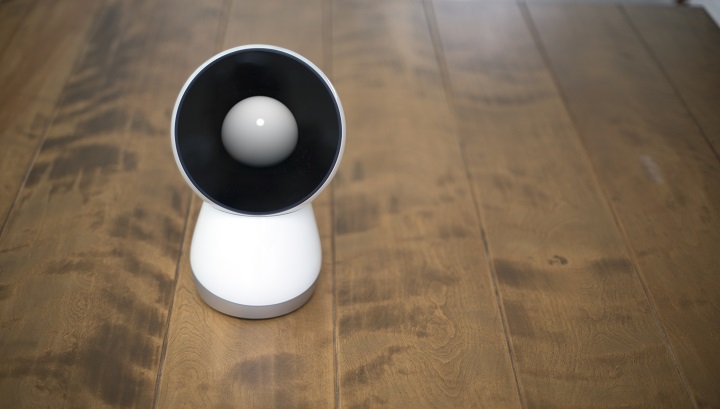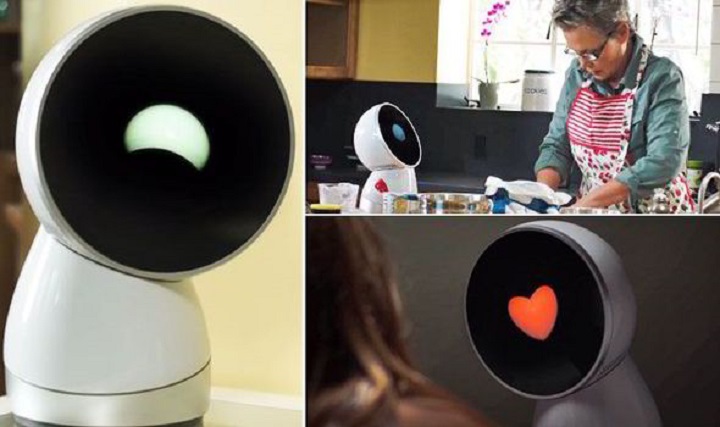
At first glance, it looks like something out of the Disney/Pixar logo - a squat, black and white robot with a swiveling head and a blinking, grey iris for a face. And in addition to providing basic household assistance - not cooking and cleaning, mind you; but being able to keeping you apprised of your emails, messages and take pictures and video of you and the family- it will be able to recognize and interact with members of the household.
Designed by MIT robotics professor Cynthia Breazeal, the Jibo robot is what is often described as "the world's first family robot". Back in August, Breazeal and the Cambridge, MA-based company she and Steve Chambers founded - a former president of voice recognition and artificial intelligence pioneer Nuance Communications - launched a crowdfunding campaign on Indiegogo to finance commercial construction of their prototype.
When it concluded this past September, the company had managed to raise a total of $2,288,407 USD from their goal of $100,000 USD, thus making them the most successful technology campaign in Indiegogo history. Amongst their contributors were such venture capital giants as New York-based RRE Ventures, Samsung Ventures, CRV, Flybridge, Fairhaven, Two Sigma, Formation 8 and Osage.

Inventor Cynthia Breazeal created Jibo to be a social robot, capable of interacting with people in meaningful ways. Credit: techcrunch.com
Designed to create a personal relationship with people, the Jibo robot is designed to perform basic household duties, such as reading to children, reciting recipes in the kitchen, taking family photos, and other helpful tasks. However, the robot also takes advantage of recent advancements made in the field of facial recognition software and machine intelligence, building profiles around different household members and recognizing them on sight.
Prior to inventing this social robot, Breazeal was the person responsible for founding MIT's Personal Robots Group. When she began designing her concept for the Jibo she began by modeled it on various animation concepts of robot helpers - an idea that has been explored extensively in science fiction and popular media. What she found was that machines didn't need to look like humans in order to achieve a social nature.
Ultimately, what she was looking for was a machine that was expressive enough for people to feel a connection with it, while hopefully avoiding any sense of "Terminator"-style creepiness. In the end, she opted for a small, compact robot with a swiveling head and a display screen that contained a single, blinking iris. And from all accounts, this was enough to give the robot a very living, sociable feel, while avoiding any robopocalyptic sentiments!
“A lot of design decisions were informed by navigating that creepiness question,” said Breazeal in an interview with Forbes. “It has to be anthropomorphic, but not pushing it too far. There’s this space of familiarity and yet still intrigue. It’s not trying to be exactly human. It’s important to strike the right balance... Jibo is a character. A lot of principals from animation that inform our work—how it moves and behaves and presents itself. The notion of character is important.”

JIBO, having raised roughly $2.3 million on Indiegogo, will now be shipping out 4800 robots by Jan of 2016. Credit: gizmodo.com
The robot's design incorporates three joints that allow the head to swivel around a full 360 degrees, track movement, monitor people's actions, and respond to their presence. When the display screen is not steaming video, displaying a web page or text, it changes in order to convey emotions, responses, and (as already noted) blinks and winks in order to appear lifelike.
The robot is also hands-free, responding to verbal instructions and executing commands. This feature is expected to be fully interactive, allowing Jibo to talk with its users and even carry on conversations. It is apparently able to do voices as well (which will come in handy for the sake of storytelling) and has a mechanical laugh - though "chortle" is perhaps a better way to describe it.
On top of that, at just 27 centimeters in height (11 inches) and weighting only 2.7 kilos (six pounds), JIbo is about the same size and weight of a conventional laptop. Though it is not yet capable of wheeling itself around, its dimensions and weight make for a highly portable design. But of course, all of this promising technology has given rise to some drawbacks and concerns, many of which have already been voiced by the tech and consumer-watch communities.
For starters, there is some skepticism that the pre-order price of $499 (or $599 for the developer version) is a bit high considering that many of the features shown in the promotional video are not yet available. Currently, the Jibo's functionality is limited to taking pictures, videos, sending messages, playing back voicemails and looking things up on the internet.

Jibo's "eye", which winks, blinks, and even emotes, creates the impression of a living being. Credit: gizmodo.com
The standard shipping model also has a few educational and entertainment apps loaded onto it, so it can do things like act out a story for children. However, the more impressive functions that were originally advertised are still awaiting development, and the company has been somewhat vague on when these will be delivered. As it states on their Indiegogo page:
"While not everything in the video will necessarily be there at launch, the JIBO skills described above are part of the core skill set. The core skill set will be released in 2015. And, because of the rich platform and ecosystem we’re building, everything in the video beyond the core skills will be possible — and more! With our developer community, we will continue to improve the product and add new and exciting features over time."
In short, the model that will be available by the end of 2016 will not include all the impressive features they promised. But as with all new pieces of hardware, this is to be expected. In order to meet their marketing and shipping deadlines, developers are often forced to exclude some of the applications they originally wanted to include, or shelve the ones that aren't quite ready for later models.

"I'm sorry Dave, I'm afraid I can't do that" - creepy words that forever influenced people's feelings about talking robots. Credit: blastr.com
What's more, in addition to being a family robot, Breazeal herself describes Jibo as also being an "open platform for social robotics". Consistent with this vision, the company plans to open the floor to developers to start making third-party apps that can be sold as easily as any others. In the coming months, Jibo will be releasing its software development kit (SDK) to interested developers and letting them expand on what the robot can do.
Thanks to the $2.3 million they collected in their first series of fundraising efforts, the company is now looking to get manufacturing and distribution up and running so they can make their pre-orders by the end of this year. According to their website and Indiegogo page, they plan to ship some 4800 units to people's homes, beginning in January of 2016.
In addition, in the wake of their first series of fundraising, the company is undergoing a bit of a shakeup in order to move into production and distribution of their product. This means that creator Cynthia Breazeal will be moving to a chief scientist roll within the company, while chairman Steve Chambers will be taking over as CEO. And it is expected that their concept will help clear the way for new species of social robots, ones which can perform increasingly complex tasks and execute human-like applications.
And while the idea of a tiny, laughing robot that watches us with a blinking, digital eye may seem a bit creepy, I think we can all agree that it's a darn sight better than some cold, calculating robot staring at us a big, glowing red eye (see image and caption above)!
In the meantime, be sure to enjoy this promotional video for JIBO. I'm sure you'll agree, it puts a happy face on the robopocalypse:
Top Image Credit: Forbes
Sources:
- www.jibo.com/
- www.geekwire.com/2014/skeptical-of-jibo/
- www.indiegogo.com/projects/jibo-the-world-s-first-family-robot--3/x/1964233
- gizmodo.com/the-worlds-first-family-robot-could-be-like-hal-in-your-1605482309
- www.forbes.com/sites/aarontilley/2015/01/21/family-robot-jibo-raises-25-million/
- techcrunch.com/2015/01/21/robotics-co-jibo-says-domo-arigato-to-25-3-million-in-cash/
- venturebeat.com/2015/01/21/jibo-closes-25m-round-for-its-personal-robot-a-cross-between-a-tablet-and-a-puppy/








